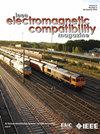高密度双向变换器电源环与栅极驱动近场耦合建模与优化
IF 2.5
3区 计算机科学
Q3 ENGINEERING, ELECTRICAL & ELECTRONIC
IEEE Transactions on Electromagnetic Compatibility
Pub Date : 2025-06-18
DOI:10.1109/TEMC.2025.3571381
引用次数: 0
摘要
随着宽带隙器件的出现,功率变换器正在实现更高性能的开关能力。因此,制造商越来越关注降低电源转换器的复杂性,并通过从模块化过渡到高度集成设计来提高生产和组装工艺,即高密度双向转换器(hdbc)。因此,近场(NF)耦合成为HDBCs稳定运行的一个重要问题。功率环路和栅极驱动(GD)的优化可以通过计算电磁学工具和电路模拟器实现,从而实现NF分布的详细可视化。此外,GD阻抗可以通过优化栅极-源走线布局进行微调,而在GD和高$\text{d}\mathbf {v}/\text{d}\mathbf {t}$节点之间设置屏蔽层时,必须考虑近电场耦合。本研究提出了一种在HDBCs中进行GD和功率环路NF耦合建模和优化的工作流程,旨在减轻低压系统中开关设备误触发和电磁干扰等问题。本文章由计算机程序翻译,如有差异,请以英文原文为准。
Modeling and Optimization of Near-Field Coupling Between Power Loop and Gate Drive in High-Density Bidirectional Converters
With the advent of wide-bandgap devices, power converters are achieving higher performance switching capabilities. As a result, manufacturers are increasingly focused on reducing the complexity of power converters and enhancing the production and assembly process by transitioning from modular to highly integrated designs, which are high-density bidirectional converters (HDBCs). As a result, near-field (NF) coupling is becoming a concern for stable operation in HDBCs. Optimization for the power loop and gate drive (GD) can be achieved through computational electromagnetics tools and circuit simulators, allowing for a detailed visualization of NF distributions. In addition, the GD impedance can be fine-tuned by optimizing the gate-source trace layout, while near-electric field coupling must be considered when implementing a shielding layer between the GD and high $\text{d}\mathbf {v}/\text{d}\mathbf {t}$
求助全文
通过发布文献求助,成功后即可免费获取论文全文。
去求助
来源期刊
CiteScore
4.80
自引率
19.00%
发文量
235
审稿时长
2.3 months
期刊介绍:
IEEE Transactions on Electromagnetic Compatibility publishes original and significant contributions related to all disciplines of electromagnetic compatibility (EMC) and relevant methods to predict, assess and prevent electromagnetic interference (EMI) and increase device/product immunity. The scope of the publication includes, but is not limited to Electromagnetic Environments; Interference Control; EMC and EMI Modeling; High Power Electromagnetics; EMC Standards, Methods of EMC Measurements; Computational Electromagnetics and Signal and Power Integrity, as applied or directly related to Electromagnetic Compatibility problems; Transmission Lines; Electrostatic Discharge and Lightning Effects; EMC in Wireless and Optical Technologies; EMC in Printed Circuit Board and System Design.

 求助内容:
求助内容: 应助结果提醒方式:
应助结果提醒方式:


